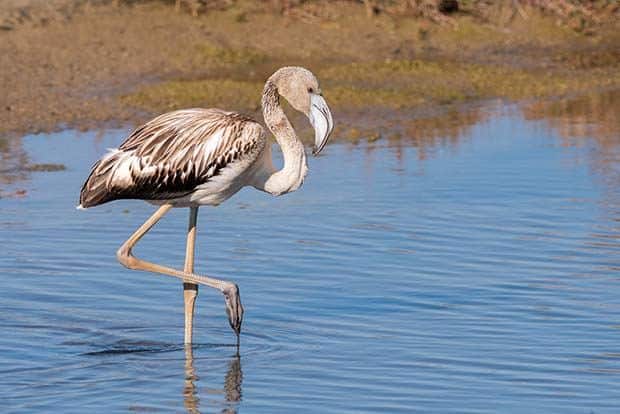It often comes as a surprise that Portugal has large populations of greater flamingos with multiple locations to view them right here in the Algarve.
As the name may suggest, the greater flamingo (Phoenicopterus roseus) is the largest of the flamingo species and can be found throughout Africa, Middle East, Indian Subcontinent and, of course, Southern Europe. This large wading bird can grow in excess of 150cm tall and weigh more than 4kg.
Plumage changes with age, with older birds having pink-tinged white feathers with darker pink sections on their wings. Black wing feathers are also visible when the greater flamingo is in flight. The adults’ legs are bright pink along with their beaks which have a black tip. Young flamingos have dark legs which turn pink along with their feathers once they reach around three years of age. The cause of the change to pink is due to the carotenoid pigments in their diet. Males and females look alike, with the males usually being larger in size.
Greater flamingos are not classed as migratory, however, they do not nest in Portugal. The flocks that are observed here leave to nest in Spain, Italy, Turkey, France and North Africa, but they do not have any regular migration pattern. This results in flamingos being able to be seen at any time of the year in Portugal, although the numbers increase in the winter.
Flocks can be found in salt water lagoons, kicking up the mud to stir-up food, then sucking the water through their strangely adapted beaks. They eat seafood (such as shrimps), algae and even seeds by using their beaks to retain the food whilst returning the water back to the lagoon. Their long, flexible necks enable them to feed upside down in the water.
The sound of a greater flamingo is very similar to that of a goose and you can easily hear a large flock communicating whilst observing. Two popular places to observe and photograph greater flamingos is Ria Formosa (Faro) and a salt water lagoon on the north-western side of the Ria de Alvor.
Other locations include Salgados and the Arade Estuary, although I have not witnessed any at the latter recently. Further afield, you can witness large flocks of greater flamingos in the Sado Estuary in Setúbal and the Tagus Estuary in Lisbon.
Although they do not nest in Portugal, an interesting fact worth mentioning is their breeding “make-up”. Secretions from the uropygial gland, which is used by birds to secrete preening oil, contains the same carotenoid pigment responsible for the pink feathers.
This secretion is rubbed over their feathers more frequently during the breeding season to enhance their colouring. This, in turn, is to help attract a mate and, although they usually bond for life, changing of mates has been observed.
Due to their size, greater flamingos are a great subject for photography within easy reach of most cameras with a modest zoom. However, they are not so tolerant of being approached and will wade or fly if their comfort distance is encroached.
Due to their light colouring, reflection of the sun can be difficult to expose, therefore, I would recommend photographing early morning or late afternoon. The lagoon at Ria de Alvor is suitable for both these times as a circular pathway around the lagoon gives opportunity from all angles.
By Craig Rogers
|| features@algarveresident.com
Craig Rogers is a Wildlife and Nature photographer from Wales now living in the Algarve offering Photography Workshops. More information, photographs and blog can be found on his website at www.craigrogers.photography






















